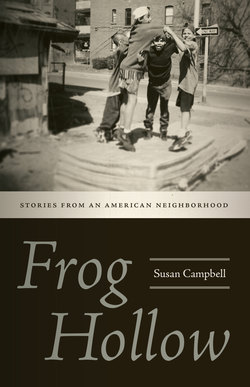Читать книгу Frog Hollow - Susan Campbell - Страница 8
На сайте Литреса книга снята с продажи.
ОглавлениеAuthor’s Note
IN WHICH THE AUTHOR EXPLAINS, WHY WRITE A BOOK?
In 1986 I moved to Connecticut to work for the Hartford Courant, America’s oldest continuously published newspaper—a phrase that still forms itself as one word in my head, even seven years after leaving that job. At the time, Hartford’s better days were behind it, or so I was told. Drug and gang wars held the city by the throat. Schools were struggling. The go-go ’80s appeared to be passing the capital city by.
But Hartford was so much more than gangs and crime and troubled schools. I know because I was there, and when I was occasionally asked to give speeches in suburban libraries or small-town schools, invariably someone would raise a hand to ask if I went into the big, scary city every day.
“Only on days I want to be paid,” I would answer, thinking I was giving their tremulous concern just the right amount of disdain.
I see now how insufferable I was. The suburbanites whose main contact with Hartford was to drive in for a concert or play, or to commute to work and then rush home at 5 p.m., were only responding to what they thought they knew. Too often, stories of the schools doing incredible things with limited resources or of trailblazers making the capital city awesome got lost, along with history and context that might have helped explain Hartford.
I made my living and my reputation in Hartford, and so I feel obligated to at least try to explain the place. I am not a social scientist or a professional historian. I am, however, a keen observer and a trained interrogator. I do not know how to tell the story of an entire city, so I want to explore one of the neighborhoods I most like.
Toward the end of my decades-long career at the Courant, when I would get angry (and that was often), I would stomp out of the paper and head south. North was Asylum Hill, which had too many busy intersections for someone who didn’t want to stop for cars but just wanted to stomp off her mad.
South was Frog Hollow, which had a vibe I couldn’t define, other than to say the neighborhood gave off the feeling of being multilayered. Something had happened here, and even if I was walking strictly to enjoy a burrito at El Nuevo Sarape or heading to look at produce I didn’t recognize at Park Street’s El Mercado, I knew as I walked past apartment buildings and bodegas that what I was seeing was only the most recent layer of a thick historical onion.
There were the trash blowing in the street and the junked cars on the roads, but there was also a pregnant sense of … something. Something happened here. So here’s to peeling back the onion’s layers and admitting that we didn’t just arrive here. Here’s to getting to the story, the real one and not necessarily the one we tell ourselves. To people lost to history who shouldn’t be. To giving credit where it’s due: generations of people climbing the ladder.
Here’s to the messy but always hopeful history of Frog Hollow.
